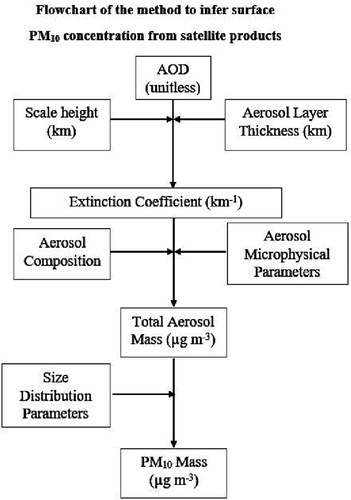当前位置:
X-MOL 学术
›
Environ. Sci. Technol.
›
论文详情
Our official English website, www.x-mol.net, welcomes your
feedback! (Note: you will need to create a separate account there.)
Seasonal Transition in PM10 Exposure and Associated All-Cause Mortality Risks in India
Environmental Science & Technology ( IF 10.8 ) Pub Date : 2018-07-12 , DOI: 10.1021/acs.est.8b00318 Pritha Pande 1 , Sagnik Dey 1 , Sourangsu Chowdhury 1 , Palash Choudhary 1 , Sudipta Ghosh 1 , Parul Srivastava 1 , B. Sengupta 2
Environmental Science & Technology ( IF 10.8 ) Pub Date : 2018-07-12 , DOI: 10.1021/acs.est.8b00318 Pritha Pande 1 , Sagnik Dey 1 , Sourangsu Chowdhury 1 , Palash Choudhary 1 , Sudipta Ghosh 1 , Parul Srivastava 1 , B. Sengupta 2
Affiliation

|
Lack of a consistent PM10 (particulate matter smaller than 10 μm) database at high spatial resolution hinders in assessing the environmental impact of PM10 in India. Here we propose an alternate approach to estimate the PM10 database. Aerosol extinction coefficients at the surface are calculated from midvisible aerosol optical depth from MERRA-2 reanalysis data using characteristics vertical profiles from CALIOP and then are converted to PM10 mass using aerosol property information and microphysical data. The retrieved PM10 are bias-corrected and evaluated (R2 = 0.85) against coincident ground-based data maintained under the Central Pollution Control Board network. PM10 exposure exceeds Indian annual air quality standard in 72.3% districts. Transition in PM10 exposure from the monsoon (Jun–Sep) to postmonsoon season (Oct–Nov) translates to 1–2% higher all-cause mortality risk over the polluted Indo-Gangetic Basin (IGB). Mortality risk increases in the central to eastern IGB and central India and reduces in Delhi national capital region in the winter (Dec–Feb) relative to the postmonsoon season. Mortality risk decreases by 0.5–1.8% in most parts of India in the premonsoon season (Mar–May). Our results quantify the vulnerability in terms of seasonal transition in all-cause mortality risks due to PM10 exposure at district level for the first time in India.
中文翻译:

印度PM 10暴露的季节性变化及相关的全因死亡率风险
在高空间分辨率下缺乏一致的PM 10(颗粒物质小于10μm)数据库阻碍了印度对PM 10的环境影响的评估。在这里,我们提出了另一种方法来估计PM 10数据库。表面的气溶胶消光系数是根据MERRA-2再分析数据的中可见气溶胶光学深度,使用CALIOP的垂直特征曲线计算得出的,然后使用气溶胶特性信息和微物理数据转换为PM 10质量。对回收的PM 10进行偏差校正,并根据在中央污染控制委员会网络下维护的一致的地面数据进行评估(R 2 = 0.85)。下午在72.3%的地区中,有10次暴露超出印度年度空气质量标准。从季风(6月至9月)到季风后季节(10月至11月)的PM 10暴露过渡期比受污染的印度-恒河盆地(IGB)高了1%至2%的全因死亡率。相对于季风季节,冬季(12月至2月),IGB中部至东部和印度中部的死亡率风险增加,德里国家首都地区的死亡率风险降低。在季风季节(3月至5月),印度大部分地区的死亡率风险降低了0.5%至1.8%。我们的研究结果在印度首次确定了因区域性PM 10暴露而导致的全因死亡率风险的季节性转变方面的脆弱性。
更新日期:2018-07-14
中文翻译:

印度PM 10暴露的季节性变化及相关的全因死亡率风险
在高空间分辨率下缺乏一致的PM 10(颗粒物质小于10μm)数据库阻碍了印度对PM 10的环境影响的评估。在这里,我们提出了另一种方法来估计PM 10数据库。表面的气溶胶消光系数是根据MERRA-2再分析数据的中可见气溶胶光学深度,使用CALIOP的垂直特征曲线计算得出的,然后使用气溶胶特性信息和微物理数据转换为PM 10质量。对回收的PM 10进行偏差校正,并根据在中央污染控制委员会网络下维护的一致的地面数据进行评估(R 2 = 0.85)。下午在72.3%的地区中,有10次暴露超出印度年度空气质量标准。从季风(6月至9月)到季风后季节(10月至11月)的PM 10暴露过渡期比受污染的印度-恒河盆地(IGB)高了1%至2%的全因死亡率。相对于季风季节,冬季(12月至2月),IGB中部至东部和印度中部的死亡率风险增加,德里国家首都地区的死亡率风险降低。在季风季节(3月至5月),印度大部分地区的死亡率风险降低了0.5%至1.8%。我们的研究结果在印度首次确定了因区域性PM 10暴露而导致的全因死亡率风险的季节性转变方面的脆弱性。











































 京公网安备 11010802027423号
京公网安备 11010802027423号